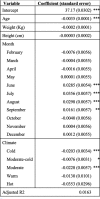Decreasing human body temperature in the United States since the industrial revolution
- PMID: 31908267
- PMCID: PMC6946399
- DOI: 10.7554/eLife.49555
Decreasing human body temperature in the United States since the industrial revolution
Abstract
In the US, the normal, oral temperature of adults is, on average, lower than the canonical 37°C established in the 19th century. We postulated that body temperature has decreased over time. Using measurements from three cohorts--the Union Army Veterans of the Civil War (N = 23,710; measurement years 1860-1940), the National Health and Nutrition Examination Survey I (N = 15,301; 1971-1975), and the Stanford Translational Research Integrated Database Environment (N = 150,280; 2007-2017)--we determined that mean body temperature in men and women, after adjusting for age, height, weight and, in some models date and time of day, has decreased monotonically by 0.03°C per birth decade. A similar decline within the Union Army cohort as between cohorts, makes measurement error an unlikely explanation. This substantive and continuing shift in body temperature-a marker for metabolic rate-provides a framework for understanding changes in human health and longevity over 157 years.
Keywords: cohort studies; historical trends; human; human biology; human body temperature; medicine; resting metabolic rate.
© 2020, Protsiv et al.
Conflict of interest statement
MP, CL, JL, TH, JP No competing interests declared
Figures









Comment in
-
Not so hot: US data suggest human bodies are cooling down.Nature. 2020 Jan;577(7790):306. doi: 10.1038/d41586-020-00074-9. Nature. 2020. PMID: 31937972 No abstract available.
References
-
- Adhi M, Hasan R, Noman F, Mahmood SF, Naqvi A, Rizvi AU. Range for normal body temperature in the general population of Pakistan. Journal of the Pakistan Medical Association. 2008;58:580–584. - PubMed
-
- Centers for Disease Control, National Center for Health Statistics . National Health and Nutrition Examination Survey Data, 1971-1974. US Department of Health and Human Services, Centers for Disease Control and Prevention; 1975.
-
- Costa DL. Union army data: early indicators of later work levels, disease and death. [February 23, 2018];2019 http://uadata.org/cite/
-
- Du Bois EF. Basal Metabolism in Health and Disease. Lea & Febiger; 1936.
Publication types
MeSH terms
Grants and funding
LinkOut - more resources
Full Text Sources
Other Literature Sources

